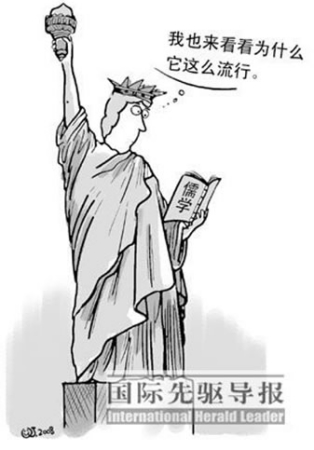2010年研究生入学考试英语作文大预测(三)
文明冲突(civilization conflict/ Huntington defines eight major civilizations: (1) Western - which includes Western Europe and North America; (2) Slavic-Orthodox; (3) Islamic - which includes three subdivisions: Arab, Turkic and Malay; (4) Latin American; (5) Hindu; (6) Confucian; (7) Japanese; and (8) African。
Huntington says that "The fault lines between civilizations will be the battle lines of the future." He continues, "Over the centuries ... differences among civilizations have generated the most prolonged and the most violent conflict" [2] - more so even than ideological conflict. The reason? - because differences between civilizations "... are far more fundamental than differences among political ideologies and political regimes ..."[3] And the evidence for Huntington's assertion is easily discernible in what's going on in the former Yugoslavia. Indeed, it's only in "civilization" (or religious) terms that any sense can be made of the alliance structures that have grown up as a result of the conflict: Germany, France and Austria (and, as a result, the E.C。) favor Slovenia and Croatia (which are Catholic and Western Christian); Russia and the "Eastern Slavs" favor Serbia (which is - like the rest of the Slavic states - Orthodox); and Turkey and Iran favor the Muslims of Bosnia (which are Islamic). Indeed, the Balkans have been a tinderbox of conflict for hundreds of years precisely because they lie at the convergence of three major civilizations (or religions) and the cultures which these religions undergird: Western Christianity (Slovenia, Croatia, etc。); Orthodox Christianity (Serbia, Bulgaria, Russia, etc。); and Islam (Turkey, Albania, etc。)。
I think, we're in a New Axial Age. The idea of Axial Age was proposed by German philosopher Karl Jaspers (1883-1969), defined as around 500 B.C. when great thinkers appeared almost simultaneous in Ancient Greece, Israel, India and China, contributing their original ideas to the problems concerning the existence of human being. Distinctive cultural traditions were then formed respectively by Socrates and Plato in Ancient Greece, Lai-zi and Confucius in China, Sakyamuni in India, and Jewish prophets in Israel, which, after more than two thousand years of progress, have become the principle part of human intellectual wealth. These local cultural traditions were independent in birth, without mutual influence. "Until today mankind has lived by what happened during the Axial Period, by what was thought and created during that period. In each new upward flight it returns in recollection to this period and is fired anew by it. Even since then it has been the case that recollections and reawakenings of the potentialities of the Axial Period - renaissances - afford a spiritual impetus." For example, the Europeans in Renaissance had recollected the origin of their culture, Ancient Greece, which had fired anew the European civilization and left its mark on global culture. Similarly, the Song and Ming Neo-Confucianism in China was stimulated by the impacts of Indian Buddhism; the Confucian thinkers, by "recollecting" Confucius and Mencius in pre-Qing Period, had promoted the ingenious Chinese philosophy to a new height. In a certain sense, the contemporary progress of global cultures might be a new leap on the basis of Axial Age. Has the contemporary human culture created, or will create, a New Axial Age then? -- Judged from certain evidences, it might be。
If Chinese culture hopes to contribute to the "coexistence of civilizations" in contemporary human society, it must needs to know itself, which means a cultural self-consciousness. The so-called "cultural self-consciousness" is the serious self-reflection by certain people in certain cultural tradition on their own culture's origin, its history of formation, its characters (including both advantages and disadvantages) and its tendency of progress. The renewal of Chinese nation is on the eve. To achieve this goal, we must have a self-knowledge about Chinese culture, posit it on a proper place, and search with enthusiasm the genuine spirit of this culture with a long history, in order to present its essence to modern human society. Besides, we must reflect the disadvantages of our culture as well, to better the absorptions of other cultures' essences, and to re-interpret it in a modern way adapting to the general tendency of progress of modern society. Only after this retrospective reflection could our country march as vanguard in the progress of global culture, and create a brave new world together with other cultures。
Confucianism and Taoism were principle schools of thinking in traditional Chinese culture, usually regarded as mutual complementary - of course, after Indian Buddhism was introduced into China, it also played an important role in Chinese society and culture. Now I'd like to discuss whether the Confucian and Taoist thinking could provide meaningful sources for the doctrine of "coexistence of civilizations"。
(1) The Confucian doctrine of Ren (仁: benevolence, virtue) is a resource of thinking with positive meaning for the "coexistence of civilizations"。
特别说明:由于各方面情况的不断调整与变化,新浪网所提供的所有考试信息仅供参考,敬请考生以权威部门公布的正式信息为准。
网友评论
更多关于 考研 英语 的新闻
- 名师指导:考研英语作文考前20天复习及预测2009-12-14 23:53:44
- 考研英语作文:按程序答题 为分数增值2009-12-11 13:04:08
- 高分速成:考研英语作文超经典实用套句2009-12-07 17:10:05
- 备考指南:2010年考研英语作文实例解析2009-11-12 18:42:08
- 2010年考研英语作文高分速成法2009-11-12 18:38:23
- 经典教程:考研英语作文结尾段落写作指导2009-11-12 18:11:07
- 名师指导:考研英语作文最后两月复习策略2009-11-12 18:07:21
- 备考倒计时:考研英语作文冲刺准备2009-11-12 18:05:39
- 层层递进 三步骤写好2010年考研英语作文2009-10-22 11:11:00







